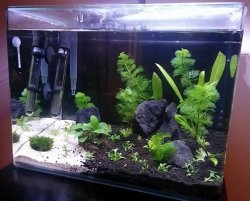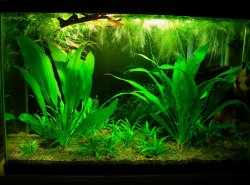Byron said:
Hi Byron, would you mind expanding on the second part? I know it's slightly differing from the topic but it's I suspect the tank in question may end up being used as a sick QT as well.
A QT for a sick fish should be relatively bare, as here you are almost certainly going to be using some sort of medication in most cases. I now have a large piece of branchy artificial wood that takes up much of the 10g, and if the day comes when I need a QT I will have this in the tank, along with a simple sponge filter and the heater. The only time so far that I have used a QT was to treat a Congo Tetra with pop-eye. I used KanaPlex (kanamycin) and resolved the problem, but the poor fish was terrified in the then-bare tank, and crashed into the tank walls more than once when I approached the tank to medicate. He busted up his mouth region doing this, so I had to deal with that too, but in the end he was fine. But it shows how un-natural and stressful a bare tank can be. I had no light over it either, can't imagine what that would have done; I did toss in a few smallish Water Sprite plants to help with water quality and provide cover. Plants are not affected by kanamycin.
If you are having to use the new fish QT as a sick tank later, then I would probably remove the plants, lower ones anyway. Decomposing plants from certain medications have to be considered. I have only once used a QT for the Congo, as most disease in my experience has been of the contagious sort, and removing infected fish is of little practical value. I have three times had internal protozoan arrive with fish, and the latter two did not show up until the fish were weeks out of QT. But these sort of issues hgave to be dealt with in the main tank.
I'm just wanting to know that I'm doing the right thing and providing the right advice. There appear to be very differing views on this subject. Some say that there should be nothing in the tank apart from plastic plumbing tubes so fish can hide. You say that a fully planted tank with substrate is fine. I prefer something in between with silk plants and the illusion of substrate (also moss balls to help with ammonia); which I fully clean down when not in use. Currently I'm raising three Golden Panchax fry in there.
I always want to do what's best for my fish and if there's an improvement I can make I'd like to do it. I feel I must be doing something right as I've never lost a fish that's been a resident of that tank.
How many times do we mention differing advice in this forum? There can be more than one way to do this or that, certainly, and sometimes it is best to do something the way that works best in that situation. I'll explain why I have had success with my planted sand-substrate QT for new fish. Members who regularly read my posts will know that I have a very scientifically-driven approach to this hobby. I believe this is a key to success. We are keeping wild creatures in a very artificial environment, but understanding their habitat, their requirements and expectations, and then providing as close as we can to that, is going to be rewarded.
I frequently acquire corys, and they will in my case always be wild caught. These fish do not travel well, they are highly susceptible to any ammonia above zero, and they have very special traits. If they are stressed sufficiently, they can release a toxin from the base of the pectoral fin spine that if released within a container bag will kill them within seconds. This is why corys so often die; I know of stores that regularly receive bags full of dead corys. When I get them home, they are acclimated to a biologically-mature tank with a fine sand substrate and a couple chunks of wood, and plants. They will never again undergo ammonia in my tanks. They have sand to sift through their gills as they naturally feed, so this settles them much faster, and they begin eating immediately. In other words, they are as close to the habitat they left a few weeks back as it is possible to be in an aquarium. No one is going to tell me that this method is not better than a bare tank.
The other thing about substrate is what goes on in it. It does not take very long for all sorts of bacteria to appear and begin to do their thing, and I am not referring solely to nitrifying bacteria either--the live plants deal with that matter better anyway. I am fortunate that I have a room dedicated to my fish, so I can have several tanks, including a permanent 20g QT for new fish or raising fry that I recover from the canisters or whatever. The substrate is the most important area in an aquarium, more than the filter. It is possible to have a healthy tank with no filter, I did this for over a year with my 10g. But you cannot manage long-term without a substrate.
Byron.
thanks for all the info.
I changed my QT a little, basically no soil, just sand and a few plants and rocks.
My main tank is still causing me grief, well actually, I'm causing myself grief.
Tank cycled, so I went and aquascaped it knowing full well ADA soil will cause some sort of ammonia spike. I didn't even use much.
last I read, Ammonia 1, Nitrite 1, Nitrate 40
I just couldn't leave it alone. Guy's ego I guess.
I could have used sand only with the same plants etc etc and I could have had cories, gourami, guppies, tetra and rasbora in there right now.




